I don’t so much have a single experience as I do a set of smaller experience that have informed my identity over course of my life. I’ve found that a large portion of identity in this modern era is influenced by the things we consume. We bond with friends and form new friendships around the tv shows that we watch, the clothes we buy, and the music we listen to. It’s easy to spend most of your time passively consuming media and products and being shaped by what we take in. However, I have always strove taken these things and been inspired to not just consume, but digest and transform them, and create my own content in turn. This has lead to a lifelong journey of dabbling in different art forms, thinking critically about the things I see, and imagining new things based on what I observe around me. Specifically, this summer, I started listening to some podcasts that really inspired me to take time to create unashamedly and be more intentional about the way I consume popular culture.
television, audio, creation, drawing, passivity, food, eyes, transformation, reflection, inspiration
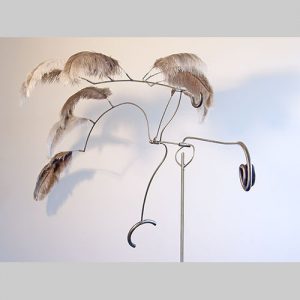 The artist of this sculpture is Alex Sanson, and the name of this piece is Soar.
The artist of this sculpture is Alex Sanson, and the name of this piece is Soar.
Immediate Responce:
When I look at this sculpture without thinking I am immediately reminded of a bird. The feathers right off the bat create this reaction. I am immediately intrigued by this piece because of its balance, yet realism. The feathers stand out in contrast to the simple wire skeleton of the sculpture. The sculpture seams free, with its wings spread open wide.
Objective Description:
This sculpture is made up of two parts, the stand, and the figure that is balancing on the stand from one fulcrum point. From tee fulcrum point there are what looks like two legs that extend down ward and one is curled in, while the other has a half circle at the end. The other two arms the extend from the fulcrum make up what look like wings spread wide open, and had real feather attached to them.
Technical Decisions:
Everything about this sculpture is free and open. The craftsmanship is simple and clean, yet unique. Starting with the title of the sculpture “Soar”, it is clear that there is a lively open and free idea to this sculpture. Next there is the fact that it so resembles a bird flying. There are actual feathers which immediately remind me of a bird, but there are also what seam to be distinctive wings that the feathers are attached to. These wings are spread apart, as if it is a bird flying. Additionally it is balancing on a stand from one point, allowing it to move around and balance freely with the wind or from a slight nudge. This as well, adds to the free ness or open soaring of the sculpture.
The Work In The World:
This type of balancing and moving artwork intrigued me because of the skill and engineering that was involved with its creation. But this was the first time I have seen a sculpture that balanced like that with actual feathers, or anything other than just metal. These feathers not only reminded me of a bird, but also of something that would be included in Native American Artwork, or something like a dream catcher. I wonder if there was a Native American inspiration of if that natural flying that the motion of the sculpture makes was what influenced the touch of the bird feathers.
The Story It Tells:
This sculpture is open and free. It allows the viewer to observe the general layout and see something that is generally familiar. A bird is generally a symbol for freeness. But there is also a sense of peaceful ness. the feathers are soothing, and are something that seam like would be used to clean. Just like the clean design of this sculpture, the detail of feathers adds to that. Additionally, this serenity goes along with Native American, and their coexistence. Despite the artificial metal used to create the sculpture, and the contrast there is with the natural feathers, they coexist in a very natural and peaceful way throughout this sculpture.
To find an artist, go to Bertrand Library and page through either the collection of books Professor Meiser has on reserve at the circulation desk OR the collection of Sculpture Magazines available on Level 2.
When getting a reserved book from the circulation desk, consider checking out one of the following titles—each of which has 100s of artists to choose from:
When you go to the circulation desk, be sure to mention that you’re in class ARST 150. Apparently it’s easier for the student workers to find reserve books by looking for ARST 150 rather than the professor’s name or the title of the course. To see the full collection of books that Professor Meiser has put on reserve, you can refer to this list.
To be relevant to our course, your artist should work primarily in three-dimensional media and be contemporary (still alive and making art today). Before selecting an artist, do a preliminary search on the web to make sure there’s sufficient information available. When you prepare for the Artist Presentation you will want to learn what the artist has said or written about their work by reviewing some interviews with the artist and/or articles about their work. These materials will help you learn about the artist’s particular agenda, set of influences, and way of working. If you can’t find any interviews or articles then look to see if the artist has written any statements about their projects. If there’s not much information out there you will want to choose a different artist.
Once you have made your selection, email the artist’s name to EVERYONE in the class, CCing Professor Meiser. Please note that each student should select a different artist. First come, first serve. Your classmates’ email addresses are posted on the “contact info” page of the class website.
Radiolarians are single-celled, individual microorganisms, similar to amoeba, often shaped with radial symmetry that can survive harsh conditions at the bottom of the sea. To help them survive these conditions, radiolarians contain pseudopods to catch tiny prey for feeding as well as silica, which creates the intricate, glasslike crystalline structures. This helps create the infinite diverse forms that gave them their name of Protists, after the Greek God of the sea, Proteus, who can take on infinite forms. Ernst Haeckel was only introduced to radiolarians in his days of studying science as a medical student at university after he found himself bored with superficial structures and dry specimens in the lab. He was raised Christian but also as a scientist, therefore he was torn between natural law/materialism and God/souls. Haeckel struggled to come to terms with both but worked throughout his career to marry the two divergent concepts through art. This was not a popular concept to unite due to the Christian church holding power over science.
One line that I found fascinating and was repeated throughout the film helped Haeckel understand how form and function can be united. “You must, when contemplating nature, understand that there is no outside or within there is only inside out and outside in.” The form itself produces the function, a concept that he arrives at through producing radiolarian art. Similarly, when creating a sculpture, the form serves a purpose; the form is the purpose. I must understand what output (reaction) will emerge form my sculpture while creating it. Although evolution does not occur through a conscious mind, it does produce forms with an efficient and effective purpose, such as the intricate, single celled microorganism that is the radiolarian.
It was fascinating that Haeckel was able to gather as many specimens as he did and completely replicate their form in art with the limited technology of the 1850’s. At that point, scientists believed that the ocean could not be as deep as 5 miles, and yet, Haeckel found specimens from 5 miles below the surface. Therefore his findings emerged at a time that the church ruled and scientific knowledge was limited. All research voyages at that time had a team of scientists (naturalists and chemists) as well as an artist to accurately depict their findings. This is where Haeckel found a calling as an artistic naturalist or a natural artist. He felt like he could grasp nature through his art, which is one implication of the projects for our class. It is a way for us to create form and function through various artistic mediums, which occurs naturally in nature. I am amazed at how painstaking his task of replicating the complex structures of radiolarians. The size and speed he had to work at was exhausting, and yet he drew out about 4000 radiolarians.
Tim Hawkinson
He is extremely conscious of how his pieces will have an auditory and visual effect on the viewer. He problem solves to create a mechanism that produces sounds of musical instruments without using complex electronics and without having prior formal engineering knowledge. The pieces evolve as he creates them throughout this problem solving process. For instance, his initial plan for the water droplets was completely abstract- he liked the sound of water droplets. As they dropped he could hear how he could produce recognizable, nonrandom rhythm involving these water droplets. From there he created a structure that encapsulates the viewer/listener and brings them to an enchanted, Dr. Seuss-esque scene of twisted, knotted plastic wrap and the flow of water. He enriches all of the senses at once.
Sarah Sze
Sarah took pride in and felt strongly connected to the building process of her piece for the highline in NYC. Often she would use a material or some kind of scaffolding originally intending for it to be taken out of the final piece but would be flexible as she had newfound connections to those materials. She was very excited to be able to alter the meaning/physicality of the piece as something new arrives. She felt as though her pieces moved through space due to this quality; it may both be fleeting and permanent, she may never know, but it fluctuates. This added to the meaning of many of her pieces that involved spaces that have been transformed in the past- such as the highline, post shutdown- and yet they still stand with beauty.
Pepon Osorio
His use of very personal memories in his art allows for self-reflection and the opportunity to learn about himself, but also pulls the audience in with a personal, empathetic connection. This makes the audience vulnerable opening them up to be more accepting of messages of the need for change in his work. He tries to produce a clear mission and understands how to use the displacement of familiar objects and scenes to portray his vision. For instance, he used bright happy, colors and familiar, childhood objects in a room with a large video projected on the wall of a son telling a father how the father’s prison sentence negatively affected him. His work his jarring but very clear due to his intentional use of materials, color and space.
When thinking about the complex idea of consciousness in animals, Nagel focuses on bats. Bats ‘see’ and ‘hear’ in a completely different way than we do, although both populations have evolved very sophisticated perceptive mechanisms over time to suit their needs. Regardless of the this similar complexity, we, as humans, have no sense that is remotely similar to echolocation in bats and therefore cannot truly feel or understand what it is like to use that as a primary sense. I can think about what it would be like for me to be a bat- if I would enjoy it, how I would feel to be nearly blind, what it would be like to hang in a tree… but those are all based on my own experiences as a human. The fact that I am human allows me to understand the quality of another human’s experiences because we are sufficiently similar enough. I have nearly the same basic information processing systems and sensory mechanisms as another human being. We have language to describe our experiences to others and we are able to understand, to a certain extent, how it feels to go through that experience. On the other hand, there is no possible way for me to understand what it is like to be a bat; I can only discover what it is like for Amy Patterson, the human, to pretend to be a bat. Regardless of this lack of understanding, bats must have some sort of consciousness because there is something that it is like to be that organism, which is Nagel’s explanation for consciousness in all organisms.
After much thought, I have finally decided to use Albert Einstein as my inspiration for our first sculpture project. You may know him as the man who discovered “e=mc^2” but he achieved far more. Albert Einstein is an eminent German-born physicist who is especially known for his theory of relativity. He is specifically near and dear to my heart due to my early childhood memories of being utterly fascinated by him. I had this huge poster of him hanging over my bed frame and before I went to sleep every night I would give the poster a little kiss. My parents thought it was rather strange but I could not stop reading his biographies. I memorized many of his famous quotes and even celebrated his birthday. I admired him so much due to the power of knowledge he held. He was not a type of person who would abuse this power but rather embrace and try to make the world a better place. An interesting thing I learned about Albert Einstein was that strangely he didn’t wear socks. He was also married to his cousin at one point which made it very apparent that it was a very different culture during his time. There are so many quirks about the character of this interesting man. He was so multidimensional and so original. He was not only intelligent but he seemed curious. He was eager and wanted to know what was out there in the world for him. Whenever I think of someone who took advantage of his growth potential, I think of Albert Einstein. I think doing a project on him would not only give me a chance to get to know him better but also create an intimate bust.
I decided to study John F. Kennedy, a politician and the 35th president of the United States of America. I chose Kennedy because he himself is a brand and was more of a public figure compared to the presidents before him. I admire President Kennedy because he is the youngest president to enter the white house. President Kennedy’s time was cut short, but he still managed to accomplish items on his agenda. During his time in office Kennedy addressed many different problems, from equality to communism. Politically, Kennedy used aggressive tactics to get things done, but also used his charm to disguise his contentious ways. I believe that most people would highlight President Kennedy political success and the advances he made in office. Others might say that President Kennedy was best known due to his assassination or some might even say he is most known for the affairs he took part in. When Kennedy was killed, something shocking was revealed to the public. President Kennedy came off as a healthy man, but what no one knew was that he had serious back issues that was made worse while he was in the military. It was so serve he had to wear a brace. Kennedy could be called one of the most loved presidents in history and that is something I would definitely want to highlight in my bust. I will make sure to bring his wit, charm, and intelligence to life in my sculpture.
Title of Event: Opera Company’s show Company
Date & Time of Event: 11/14/14 at 7:30pm
Location of Event: Weis Recital Hall
Type of event: Musical
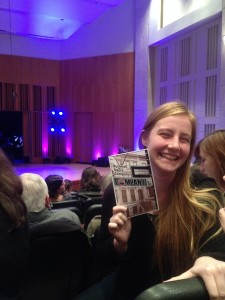
It is often thought that humans are the “greater” species because we can feel deep emotions. However, animals have emotions too, which they express through sound and body language. Although we may not truly be able to understand what the animal is feeling, we cannot disregard animals as unfeeling beasts.
To submit your final design please follow these instructions:
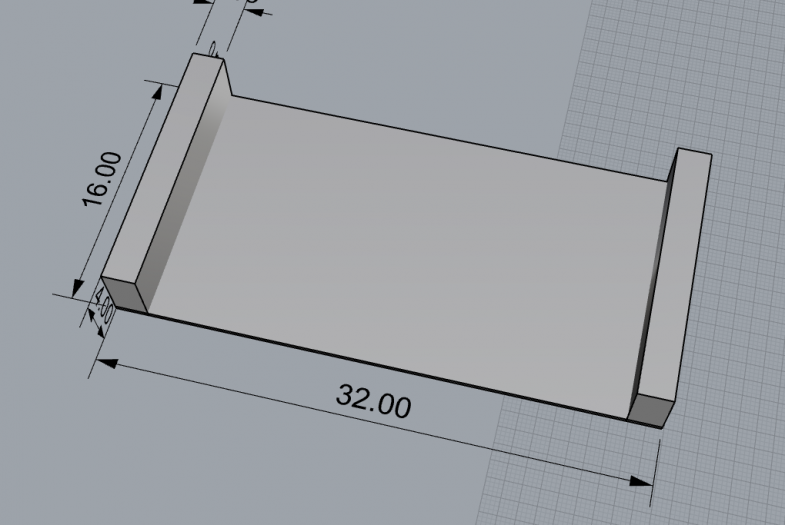
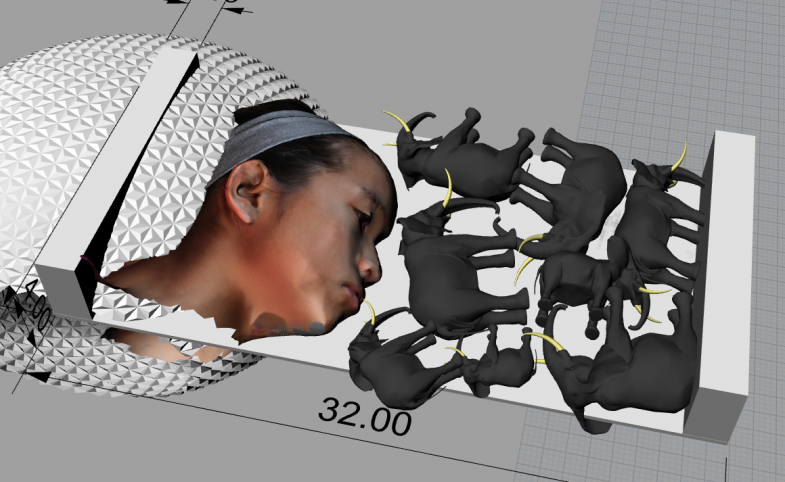


Once you’ve completed the steps listed above, please put your final file in the digital sculpture dropbox. You can get there by following this path: Click the start button in the lower left corner of the screen > click Computer > Projects > Digital Sculpture > Public > drop_box
After turning in your file, please create reference images to use for the carving process by following these instructions:
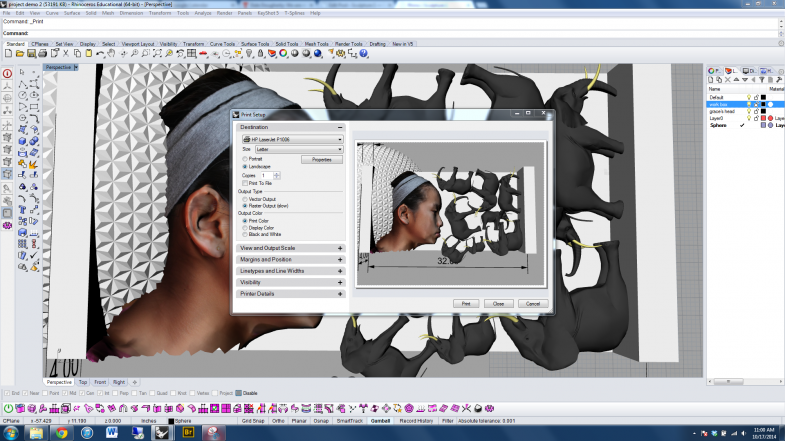
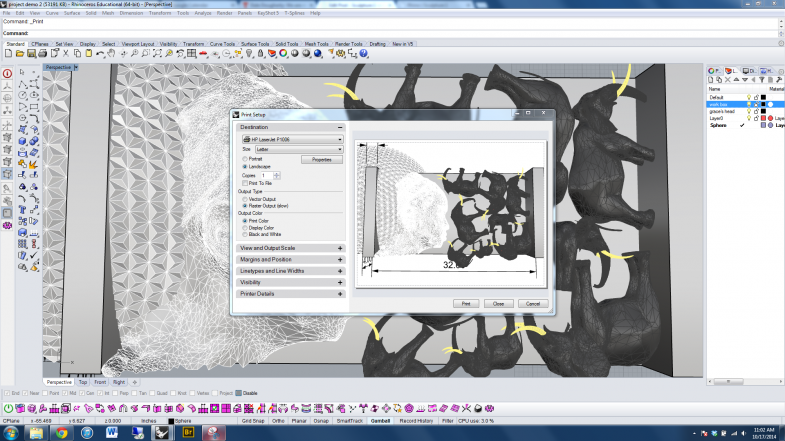
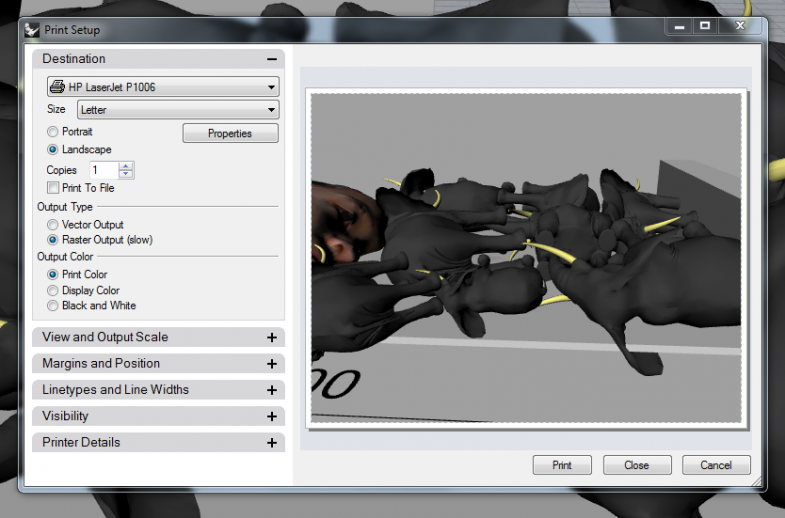
I encourage you to print several images of your design from different angles. These images will be invaluable when working in the sculpture studio.